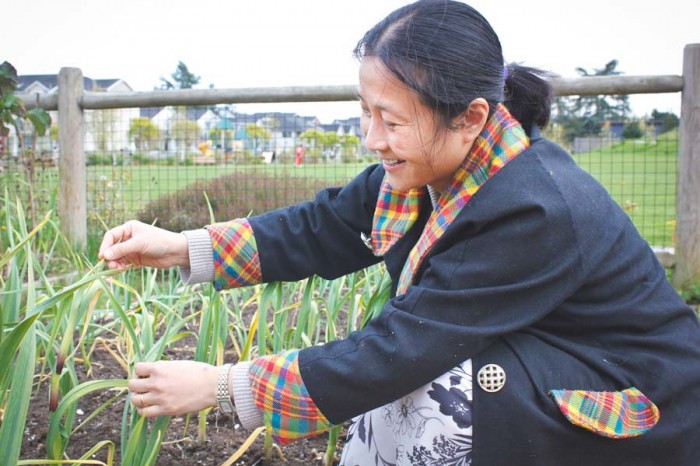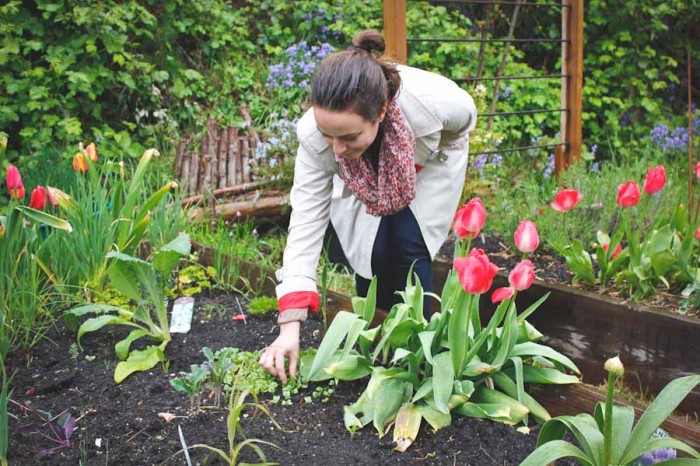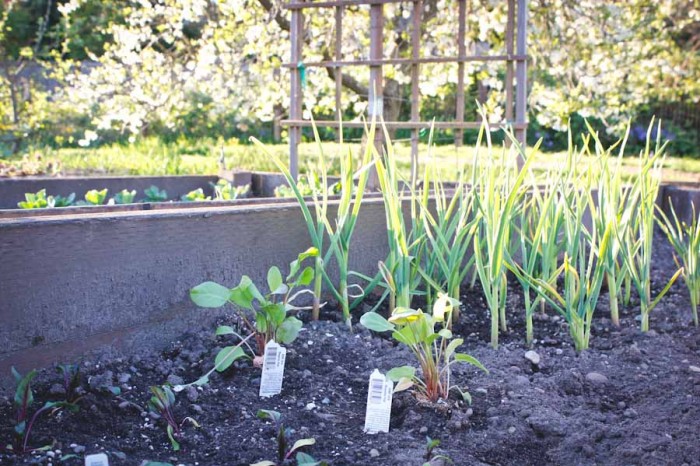
Slowly, reluctantly, in spurts, spring is coming to Seattle, and P-Patch gardens all over the area are waking up from winter slumber.
Each week, a few more gardeners brave the rain to check in on their plots, and when the sun makes an appearance, they turn out in full force to till, fertilize, sow seeds, transplant starts, and resume the perennial fight against weeds and slugs.
I am now in my fourth year in the Queen Anne P-Patch, where the gardeners are overwhelmingly U.S. born. A foreign accent like mine is a rarity in our Patch, and when a gardener I haven’t met stops by my plot to chat and learns that I am from Russia, they often ask if I am growing anything uniquely Russian. Casting about for an example, I look around my two garden beds, filled with various lettuces, strawberries, and our Pacific Northwest favorite, kale, and eventually acknowledge that, no, nothing in my plot is really that “Russian.”
Surely, I thought, other immigrants are growing something a little more exciting, more representative of their native land?
“Don’t be surprised, I don’t have Chinese vegetables in my plot and I didn’t have time to plant spring vegetables yet,” my Neighborhood House co-worker, Audrey Turpaud, warned me in an email. But she agreed to meet on a chilly, gray April afternoon after work to give me a tour of her P-Patch.
Originally from China, Audrey now lives in High Point, a former West Seattle public housing project that was recently redeveloped into a mixed-income community. A neighborhood created with sustainability in mind, High Point boasts three P-Patches, including one of Seattle’s two “market gardens,” which offer CSA shares, allowing the mostly immigrant and refugee gardeners to earn an income by applying their agricultural skills.
“All I have in here right now is garlic,” Audrey gestured at her plot in the Commons Park P-Patch. I knew that garlic is commonly used in Chinese cuisine, and assumed that Audrey would probably mince or slice those pungent cloves once they were fully developed in a month or two, and then stir-fry or sauté them them with meat and vegetables in familiar dishes from Chinese restaurant menus. I was in for a surprise.
It turned out that Audrey had completely different plans for her garlic bounty: she would pick the bulbs once they were nice and plump, but before they had a chance to separate into individual cloves, and then pickle them in a mixture of vinegar, salt, and sugar.
Audrey explained that the plants had another use as well: the young green stalks that would soon sprout from the garlic plants could be cut off before the flower head was fully grown, and pan fried for a delicious vegetarian side dish. A quick Google search after I got home revealed that these stalks are known as “garlic scapes” — a term I’d heard before but always assumed it referred to some sort of a wild garlic relative.
“I keep telling my garden neighbors that they can cut off the stalk and the garlic will keep growing in the ground, but they are afraid that their garlic will die, and they won’t do it,” Audrey mused.
What will Audrey plant once all that garlic is harvested? Peas, tomatoes, and peppers are on her list. “These will keep us pretty busy,” Audrey smiled.
No Chinese produce, then? No bok choy or gai lan?
“I don’t know how to cook Chinese vegetables, so I don’t plant them,” Audrey laughed. “My mother is the cook in the family.”
Audrey did, however, point out some Chinese produce in an adjacent plot, including tiny starts of what looked like various leafy greens and a low-growing, shrub-like plant with small oblong leaves that the plot owner told Audrey was very good for eyesight.

“I do not think I have anything unconventional in my plot except maybe my love for French thyme and other herbs used in the French cuisine,” wrote Celia Payen, a native of France, who has tended a plot in Shiga’s Garden in the U-District since 2010.
Indeed, many of the plants in her plot looked familiar — lettuce, strawberries, potatoes, garlic, kale, radishes, and turnips, as well as an abundance of colorful tulips (“my favorite flower,” she remarked.)
I did, however, spot a few things I did not recognize — some of which turned out to be French (more on these in a moment), and some, not so much, like the tall, light green stalks of lemongrass, which Celia told me she liked to use in curries.
“What is that?” I asked, pointing to a bunch of large, elongated, vaguely artichoke-like leaves sprouting in the middle of the plot.
“Ah, this one is very French,” Celia smiled. “It is a cardon.” The leaf stalks were the edible part, she explained. So, what does one do with cardon (cardoon) stalks? Celia’s grandmother used them in a classic Lyonnais recipe called cardons a la Moelle, which involves boiling the cut-up stalks first in water, then in veal stock, and finally serving them with cooked bone marrow.
I was also intrigued by the way Celia proposed to use some of the familiar plants in her garden. Case in point #1: turnips. Most recipes I’ve seen online call for boiling and mashing turnips, much like potatoes, or throwing them into a roasting pan with a variety of other root vegetables. Celia, however, braises the turnips with shallots, then adds black trumpet mushrooms and thyme, and finishes the stew with “a good splash of port.”
And more new uses for garlic. After learning about Chinese pickled garlic from Audrey, I suspected that Celia might also have a recipe for this versatile plant that transcends the stereotypes of French cooking. Indeed, it turned out that one of her favorite ways to use garlic was to cut off the top of the bulb and roast the garlic in a hot oven, a process that turns the garlic cloves soft, sweet, mellow, and “so good you can eat them with a spoon.”

A few days after meeting with Audrey and Celia, I dropped by my own P-Patch.
As I gently sprinkled water on the ground that held germinating radish seeds, I saw my plot in a different light. I realized that what makes my garden uniquely Russian is not so much the plants I grow there, but how I use my harvest.
Once those radishes are ready to pick, I will slice them into a classic Russian springtime salad that combines radishes with hard-boiled eggs, green onions, and sour cream. And my garlic? If the weather gods smile upon us again this summer and my tomatoes are as plentiful as they were last August, I might try making gorlodyor, the Russian take on salsa that my husband grew up eating, involving tomatoes and a copious amount of garlic ground into a juicy, pungent puree.
No matter how much I love my traditional Russian recipes, however, I will be sure to set aside a few bulbs to try my hand at Audrey and Celia’s garlic preparations!


Hi, Irina,
Great article! I loved it. And remember the radishes you used for the dishes you made for the cooking class.
Nice work!
Hope to see you in the garden.
Betty
Betty,
Good to hear from you! Thank you for your kind words – glad you enjoyed the article! I’ll be in the garden a lot this week as I built a hoop house this past weekend in one of my beds and planted some cucumber starts, so I’ll be stopping by every morning to open it up and every night to pull the plastic down again. Hopefully I’ll see you in the garden one of these days!
Irina